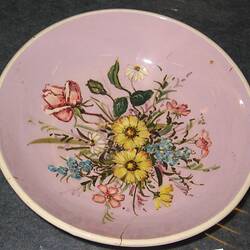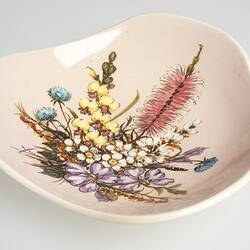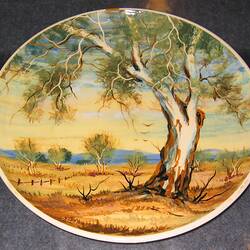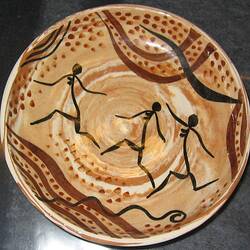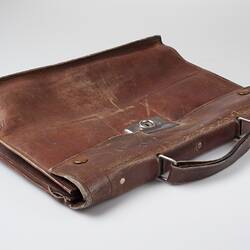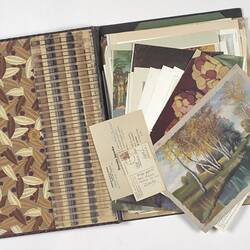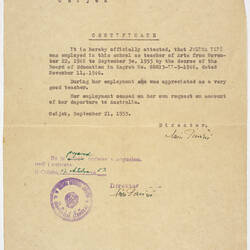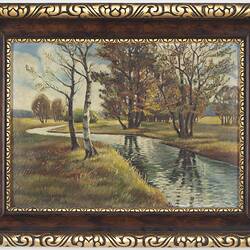Helen Ilich (nee Popovic) was a Serbian, born in the town of Osijec, Yugoslavia (now Croatia) on 19 February 1914. She was taught art by a Russian immigrant who lived in the area and hoped to attend art school in Vienna.
However her father resisted the idea and instead encouraged her to marry, which she did in 1934, marrying Bozidar Ilich (born in 1908), a Serbian from a poor family. He had hoped to study, but instead joined the army. Helen continued to paint at home until the birth of her son Vojislau in 1937. She also had a daughter, Nina, who was born in 1934.
During World War Two Bozidar was captured by invading Italians and held captive for several years. Upon his release he walked to Switzerland and enrolled in an architecture course for six years. During this time Helen worked as a high school art teacher in Yugoslavia.
In 1950 Bozidor immigrated to Melbourne and was initially employed dredging the docks. However around 1953 he gained employment as an architect with the Public Works department. The same year he arranged for his family to migrate to Australia with the assistance of the Red Cross. Helen and the children travelled on the SS Oceania (via Trieste - Genoa - Naples - Messira - Suez - Port Said - Aiden - Colombo - Fremantle) in the lower berths, which let in water when the seas were rough. Despite this discomfort Nina recalls enjoying the journey. Helen brought three to four crates with her, one of which held selected special paintings - a portrait of her grandmother, a landscape and a still life.
When his family arrived Bozidor bought a house in Richmond - he had previously been living in Spring Street - and the family were sent out to work. Helen worked as a kindergarten assistant, Nina worked with a dressmaker and Vojislau worked on building sites. Nina and Vojislau did eventually attend school, MacRobertson and RMIT respectively.
Around 1955, Helen joined the Ellis ceramic studio in Fitzroy, which had been established by two Czechoslovakian immigrants, Dagmar and Miloslav Kratochvil, in the mid 1950s. Helen did decorative features on pots and vases (etching) before firing. This was paid as piece work and she left the studio due to the dust.
She then joined Guy Boyd's studio in East Bentleigh in 1956 or 1957 and was employed doing decorative paintings on the ceramics, according to Boyd's directions. Boyd also encouraged Helen to do souvenir brooches, which she particularly enjoyed. Guy Boyd Pottery produced a wide range of modernist objects from house-wares to decorative pieces, featuring iconic Australian imagery, particularly flora and indigenous motifs.
Helen remained at Boyd's for two to three years, but left at the request of her husband. She went to work with Isobel, who had worked with her at Boyd's, but left to start her own studio in a backyard shed in Oakleigh. The conditions were basic and the travel times long. Helen worked with Isobel for about two years and also worked part-time at Ellis, as they had requested her return.
In 1959 Helen and her family moved from Richmond to Eaglemont, where she set up a studio in her home, teaching women oil painting. In the late 1960s she joined the Heidelberg District Artists' Society and exhibited in Heidelberg, in Fitzroy during Moomba and at the Camberwell Town Hall. She sold a small amount of work and continued teaching throughout the 1960s, but eventually stopped due to her husband's complaints about the smell, but recommenced after his death in 1992. She continued painting until about six years before her own death on 18 February 2002.
Helen generally painted in oils on board and canvas as she found watercolours difficult. Her style was naturalistic and landscapes were her favourite subjects, although without a car she struggled to undertake en plein air paintings. Her inspiration for her landscapes largely came from a folio she created of magazine clippings, catalogues and friends' photos of the Australian Outback and other locations, as the furthest she travelled after her arrival in Melbourne was to Magnetic Island. Because of her limited mobility, she did do still life work and some portraits, as she found the subjects more manageable.
Helen admired Australian artists such as Hans Heysen, Russell Drysdale, Arthur Streeton, Fredrick McCubbin, and also appreciated Aboriginal art. She loved Australia and its landscape particularly, wattles, evergreen trees, gum trees with their stripping bark, sheep and horses (she rode as a child), the sky, the climate and the light. Despite facing difficulties in her struggle to become an artist, including family opposition and domestic isolation, Helen persevered through the imagery provided by friend's travel photos, clippings from magazines and calendars and her own immediate environment.
More Information
-
Keywords
-
Authors
-
Article types










